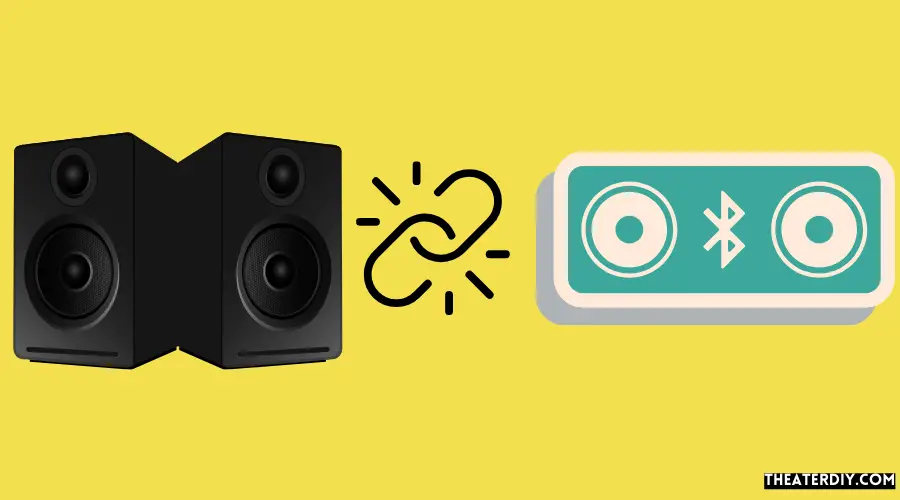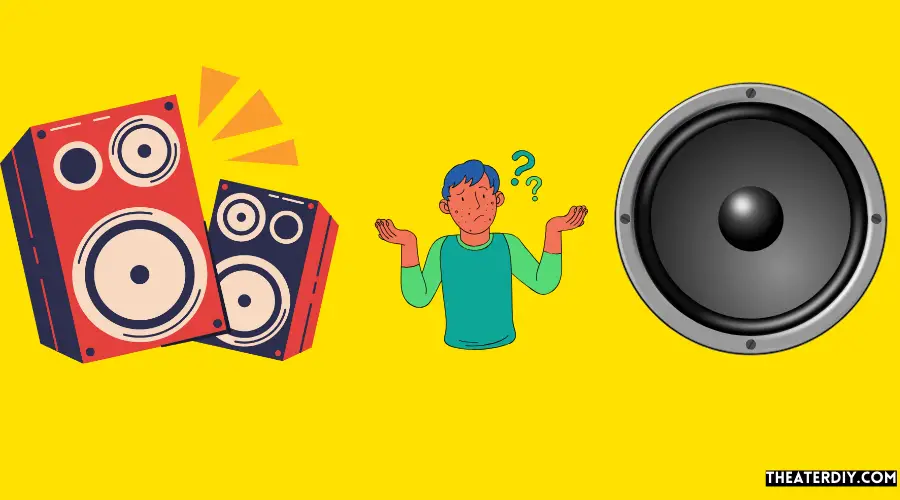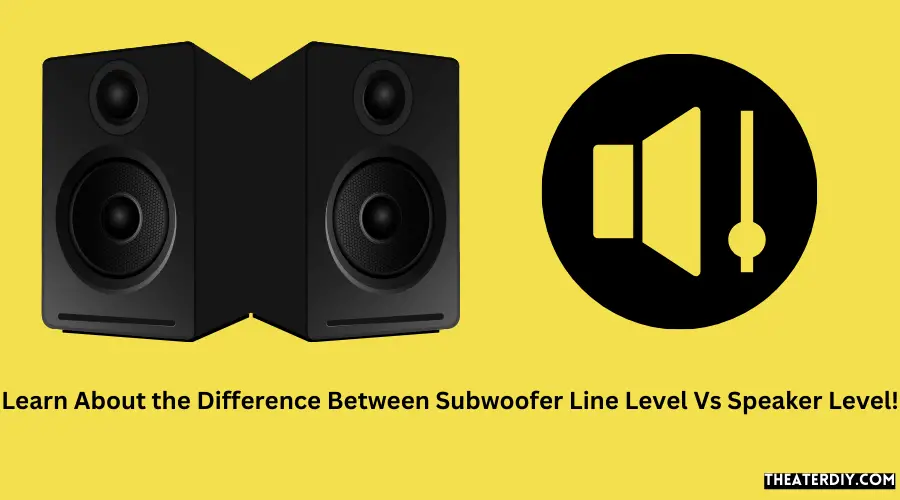Subwoofers are designed to reproduce low-frequency sounds (bass) and require a power amplifier. There are two different ways to connect a subwoofer to an amplifier; via speaker level inputs or line level inputs. The main difference between the two types of connections is the amount of noise that will be introduced into the system.
What is the Difference between Speaker Level And Line Level?
The difference between speaker level and line level is that speaker level is the output of an amplifier, which is designed to drive a speaker, while line level is a preamplifier signal that has not been amplified.
Speaker level signals are usually much higher in voltage than linelevel signals. For example, a typical home stereo receiver puts out about 1 volt (RMS) of power at its speaker outputs.
That same receiver might have a line-level output voltage of only 200 millivolts (0.2 volts). So the speakers get 100 times more power than the line-level device. The extra power is needed to make the speakers move back and forth enough to create sound waves in the air.
What Level Should a Subwoofer Be Set At?
There is no definitive answer to this question as it depends on a number of factors, including the size and acoustics of your room, the type of music you listen to and your personal preferences. However, there are some general guidelines that can help you find the right level for your subwoofer.
If you’re just starting out, it’s best to begin with a moderate setting and then gradually increase the volume until you find the sweet spot.
It’s also important to make sure that your subwoofer is properly calibrated so that it doesn’t overpower the rest of your speaker system.
Once you’ve found the perfect level for your subwoofer, sit back and enjoy the rich, deep bass that will add new life to your music collection!
What is Speaker Level Input on Subwoofer?
Speaker level input is a type of audio input that allows a subwoofer to be connected directly to an amplifier, without the need for a separate line level connection. This makes it possible to connect a subwoofer to an amplifier that does not have a dedicated subwoofer output.
The speaker level input on a subwoofer is typically a set of binding posts or banana plugs that are wired in parallel with the main speakers.
This allows the signal from the amplifier to be divided between the main speakers and the subwoofer, with the subwoofer receiving only the low frequency signals that it can reproduce.
In order for this to work properly, the impedance of the speakers and subwoofers must be matched. If they are not, then there will be an uneven distribution of power between them and the sound quality will suffer.
Additionally, care must be taken not to overload the amplifier by using too many watts of power per channel.
Overall, speaker level input can be a great way to connect a subwoofer to an existing stereo system without having to make any major changes or additions. It is important to keep in mind, however, that proper impedance matching is essential for optimal performance.
Is Subwoofer Line Level Out?
A subwoofer is a loudspeaker designed to reproduce low-frequency sounds. The typical frequency range for a subwoofer is 20–200 Hz for consumer products, below 100 Hz for professional live sound, and below 80 Hz in THX-approved systems. Subwoofers are generally used in conjunction with main speakers that handle the higher frequencies.
There are three types of connections that can be used to connect a subwoofer to an audio system: line level, speaker level, and LFE (Low Frequency Effects). Line level is the standard connection used between a preamplifier or receiver and the subwoofer. The signal sent through this connection is identical to the signal that is sent to the main left and right speakers.
Speaker level connections are typically found on home theater receivers and some car stereo amplifiers. These types of connections use the same wires that are used to connect the main left and right speakers to the receiver or amplifier. The third type of connection, LFE, is found on AV receivers that have Dolby® Digital or DTS® Surround Sound decoding capability.
This type of connection carries only the low-frequency information that has been specifically encoded onto the movie soundtrack or music recording.
All three types of connections will work with any brand or model of subwoofer; however, using different cables may be required depending on which type of connection you are using. For example, if you are connecting your subwoofer using speaker-level inputs, you will need heavy gauge speaker wire rated for high currents (Amperes).
How to Connect Speaker Level Input Subwoofer?

If you’re looking to add some serious bass to your car audio system, then you’ll need a subwoofer with speaker level input. Here’s a quick guide on how to connect your subwoofer:
1. Start by disconnecting the negative (-) battery terminal to avoid any short circuits.
2. Next, identify the positive (+) and negative (-) wires on your subwoofer. The positive wire will typically be red, while the negative wire will be black or white.
3. Once you’ve identified the wires, connect the positive wire to the positive terminal on your car’s battery, and connect the negative wire to a good ground point on your car (such as a metal bolt).
4. Finally, reconnect the negative (-) battery terminal and turn on your car stereo. You should now have some seriously deep bass in your car audio system!
Speaker Level to Line Level Adapter
If you’ve ever tried to connect a turntable or other audio source directly to a receiver or amplifier, you know that it doesn’t work. The reason for this is that the output from these devices is “line level” while the inputs on most receivers and amplifiers are designed for “speaker level” signals. In order to connect these two types of devices, you need a speaker level to line level adapter.
There are a few different ways to build one of these adapters, but the basic idea is to use a resistor network to attenuate the signal from the speaker output so that it can be safely input into the line-level input on your receiver or amplifier. The exact values of the resistors will depend on the impedance of your particular device, so it’s best to consult a professional if you’re not sure what values to use.
Once you have your adapter built, simply connect the positive lead from your turntable (or other audio source) to the positive terminal on your adapter, and then connect the negative lead from your turntable to the negative terminal on your adapter.
Then, just plug the other end of your adapter into any free line-level input on your receiver or amplifier and you’re good to go!
Mic Level to Line Level
As an audio engineer, one of the most important things to understand is the relationship between mic level and line level signals. Mic level signals are much weaker than line level signals, which is why they need to be amplified before they can be sent to a mixer or other type of audio equipment. There are two main types of microphones: dynamic and condenser.
Dynamic microphones require less amplification than condenser microphones, but both types will benefit from being run through a preamplifier before they are sent to the mixer.
One way to think about the difference between mic level and line level is in terms of voltage. Most professional microphones have an output voltage that falls somewhere between 1 and 10 millivolts (mV).
Line level signals, on the other hand, typically have an output voltage between 200 and 600 mV. So, in order for a mic signal to be strong enough to work with line level equipment, it needs to be amplified by at least 20 times.
There are a few different ways that this amplification can happen.
The first is with a stand-alone preamplifier, which will take care of boosting the signal from the microphone before it reaches the mixer. The second is with a mixing console that has built-in preamps for each channel. And finally, some digital recorders have what’s called an analog-to-digital converter (ADC) that takes care of boosting the signal before it’s converted into a digital format.
No matter what method you use to boost your mic signal up to line level, it’s important to make sure that you don’t introduce any unwanted noise into the system in the process. This means using high-quality cables and connectors throughout your setup, as well as making sure that your preamp or ADC is properly grounded. By taking these precautions, you can ensure that your recordings will sound their best from start to finish!
Mic Level Vs Line Level Db
If you’re new to recording, you may be wondering what the difference is between mic level and line level. Both are types of audio signals, but they are used for different purposes. Here’s a look at the differences between mic level and line level so you can decide which is right for your needs.
Mic level signal strength is measured in decibels (dB), and it indicates how much power is being transferred from the microphone to the recording device. The higher the dB, the more powerful the signal. Line level signal strength is also measured in decibels (dB), but it indicates how much power is being transferred from one piece of audio equipment to another.
For example, if you’re sending a signal from your mixer to your powered speakers, the line level would be measured in dB.
The big difference between mic level and line level signals is that mic levels are designed to be amplified, while line levels are not. That’s because microphones need amplification in order to boost their weak signals so they can be properly recorded or broadcast.
Line Level Vs Instrument Level Voltage
There are two types of voltage in audio: line level and instrument level. Line level is the standard voltage used in home and professional audio equipment. It is typically around 1 volt, give or take a few dB.
Instrument level voltage is the voltage produced by an electronic instrument, such as a guitar or keyboard. It is usually much lower than line level, about 0.1 volts or less.
The main difference between these two types of voltage is their respective levels of power.
Line level voltage has enough power to drive speakers and other components that need high levels of current. Instrument level voltage, on the other hand, is not powerful enough to do this and must be amplified before it can be used to drive anything else.
Instrument level signals are also more vulnerable to noise than line level signals.
This is because they have less power to start with, so any interference will have a greater effect on them. For this reason, it is important to use shielded cables when connecting instruments to amplifiers or other devices.
High Level Input Vs Low Level Input Subwoofer
When it comes to subwoofers, there are two types of input signals that you can use: high level and low level. Which one you choose will depend on your particular setup and what kind of sound you’re looking for. Here’s a breakdown of the differences between high level and low level input subwoofers:
High Level Input Subwoofer
A high level input subwoofer gets its signal from the same source as your speakers. This means that it’s getting a signal that has already been amplified, so it doesn’t need any additional amplification itself.
High level input subwoofers are typically easier to install than low level ones, since you don’t need to run any extra wires. However, they can sometimes produce less than ideal sound quality because the signal is already being processed by your amplifier before it reaches the subwoofer.
Low Level Input Subwoofer
A low level input subwoofer gets its signal from your receiver or amplifier directly. This means that the signal is unamplified, so the subwoofer will need its own amplifier. Low level input subwoofers usually provide better sound quality than their high level counterparts, but they can be more difficult to install since you’ll need to run extra wires from your receiver or amplifier to the subwoofer itself.
Subwoofer High-Level Input Vs Rca

When it comes to choosing the right input for your subwoofer, there are two main options: high level input and RCA. So, which one is better?
High level input is typically used when connecting a subwoofer to an amplifier or receiver.
The signal is sent through the speaker wire, which means that it’s already been amplified. This can provide a stronger signal and often results in better sound quality.
RCA inputs, on the other hand, are best used when connecting a subwoofer to a preamp or source component.
The signal is unamplified and can be weaker than with high level input. However, this connection can still provide good sound quality if done properly.
Line Level Voltage
Line level voltage is the DC voltage that appears across an electrical conductor. It is measured in volts and is typically between 0 and 5 volts. The line level voltage may be AC or DC, but it is usually AC.
The most common line level voltages are 3.3 volts and 5 volts.
Conclusion
If you’re looking to add a subwoofer to your car audio system, you’ll need to decide whether to use a line-level or speaker-level input. Line-level inputs are typically used with aftermarket head units, while speaker-level inputs are used when adding a subwoofer to a factory stereo. So, which one should you use?
Here’s a quick overview of the differences between line-level and speaker-level inputs:
Line level inputs are lower in voltage and have less power than speaker level inputs. This makes them ideal for aftermarket head units, as they won’t overload the head unit’s internal amplifier.
Line level inputs also provide better sound quality than speaker level inputs.
Speaker level inputs are higher in voltage and have more power than line level inputs. This makes them ideal for factory stereos, as they can handle the high output of the stereo’s internal amplifier.
However, because speaker level input signals are more powerful, they can cause distortion at high volumes.

